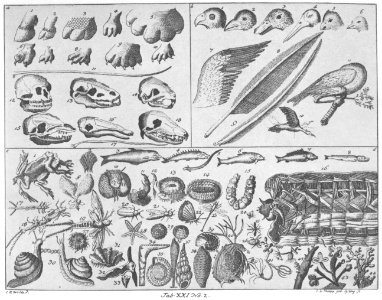Tab. Xxi. No. 2. On the knowledge of animals. A) feet with hooves and toes of four-legged animals 1-9. A foot with a web 10. A hair 11; heads defleshed because of the difference in teeth 12-16 and 18; the tongue 17 of the toothless anteater. - b) heads of birds, classified according to their beaks 1-6. A wing 7, a feather 8 and an enlarged fiber of the same 9. A sleeping bird on a tree 11. A bird flying down 10, and the position of one flying up, indicated by dots. - c) two fertilizing frogs 1; also the scale of a fish 2. A dolphin 3 and sturgeon 4 (which grow to 20 feet long and are therefore represented here in the most reduced form). A fish without ventral fin feathers 5. Three more species of fish (drawn to show somewhat the position of their fin feathers). The ovary of a bee 9; a head of the same 10. A forefoot 11, a claw 12 and two metatarsals 13, 14, of a caterpillar 15. The forepart of a caterpillar opened on the back, as it appears after a certain preparation and through the magnifying glass 16. A lizard, as it lives in water 17, as it sheds its skin 18, and as it is a winged insect 19. A beetle 20, a cicada 21. A butterfly 22; a water nymph 23; a gall insect 24; a mosquito 25 and a louse 26. The head of a jellyfish 27; a starfish 28. A sea urchin with its spines and stripped of them 29. Two snails 30; mussels and snails of various kinds 31–39. A very enlarged water flea with flower polyps on its back 40, and two water fleas in natural size. Two types of arm polyps 41; also some flower polyps hanging on a leaf 42, and one of them enlarged 43. A reduced-size coral plant. (description according to source). Date: 1774.
Loading...
